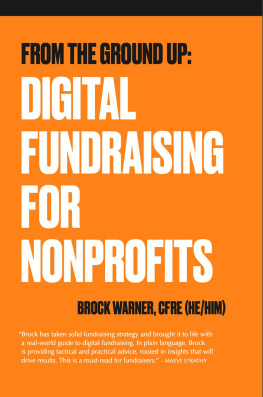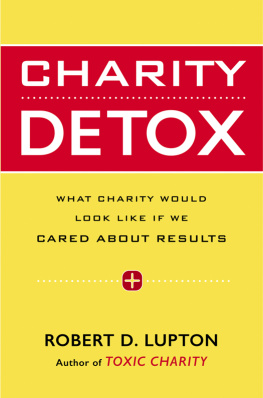Bill High with Ray Gary
Foreword by Dan Busby, President, ECFA
Charity Shock.
2018 Bill High, Ray Gary. All rights reserved. No part of this book may be reproduced in any form or by any electronic or mechanical means including information storage or by any retrieval systems, except for brief quotations in printed reviews, without prior permission in writing from the authors.
Cover and interior design by Stephanie Ibarra.
DEDICATION
To all those who labor diligently in ministry for the greater good: your sacrificial service is to be commended. May this book provide greater fuel for your mission.
Ive had the opportunity to work with Bill in both the business and nonprofit world. Ive found his advice to be valuable and his foresight to be instructive. I highly recommend this book. Additionally, as chair of the Museum of the Bible, we are implementing many of these cutting-edge fundraising thoughts.
Steve Green | President, Hobby Lobby, Inc.
Charity Shock is the new field guide for effective fundraising. Bill High and Ray Gary offer nonprofit leaders an eyes-wide-open survey of the changing landscape. They cover the new frontier, threatening terrain, alternative routes, and how to master the tools sure to unlock generous giving. This book equips you well with exactly what you need to deeply engage all generations in your ministry and mission.
Tami Heim | President & CEO, Christian Leadership Alliance
Occasionally in your life you come across that guy. The one that challenges you through his creativity and intellect to think differently about fundraising and family generosity. Bill High is that guy. I am honored to have worked with him in a variety of different capacities over the past twenty years. When it comes to creative giving strategy and major donor engagement, he is the go-to guy. I can only give my highest recommendation and endorsement of the man and his writing.
Tim Smith | Former Chief Development Officer, Museum of the Bible; and current President, Timothy Smith & Associates
Is your ministry skating to where the puck of donor dollars used to be? If so, Bill High has written a masterpiece of must-read wise counsel for you! After painting a compelling picture of the changing landscape in ministry fundraising, Bill helps you transition away from the wave of whatever former successes youve had in this area, and toward the emerging opportunities before you now with older donors, new technologies, giving beyond cash, and much more.
Mike Buwalda | Founder of Money for Ministry, planned giving services, and host of the Christian Leadership Alliance Encore webcast series
CONTENTS
FOREWORD
As the president of the Evangelical Council for Financial Accountability (ECFA), I have the opportunity to work with many nonprofit organizations and churches around the country. Part of our aim is to make the nonprofit world better by providing and enforcing uniform standards. That desire to make the nonprofit world better is one of the reasons why Im writing this foreword.
Bill High and Ray Gary have written a masterful and necessary work for the nonprofit world. As I read the manuscript and consider the trends theyve outlined, I cant help but think of my nightly weather forecast. Its great to be able to turn on the television, the radio, or my computer and look at predictions for what the weather will hold.
On the other hand, when I think about those weather forecasts, it makes me realize that we have no weatherman for the nonprofit world. But things change, conditions change, and someone needs to forecast how those changes will affect the nonprofit world.
Thats what Charity Shock is aboutproviding a forecast to the nonprofit world. And I believe that shock really should be in the title. Things are changing. Some of that change is great. Some of it will bring real opportunity. Some of it will not. But Im afraid that many in the nonprofit sector are not ready or even aware of that change.
Even in the work of the ECFA, Im surprised by how many organizations are not aware of rule changes that negatively impact their operations. So many times, those organizations get caught in the same patterns of doing work the same old way.
Change is in the wind. Im hoping that the whole of the non-profit world will read this book and adjust to those changing winds. Those adjustments will help determine the strong future of service nonprofit organizations bring to our world.
Dan Busby
President Evangelical Council for Financial Accountability
PREFACE
Have you felt the tremors? Over the past decade, the ground we stand on as fundraisers has shifted dramatically.
After the economic crash of 2008, many news articles came out lamenting how long it would take the fundraising world to get back to normal. At The Signatry, we were quick to warn the nonprofits we worked with that we were facing a new normal. Fundraising methods that had worked in the past wouldnt work much longer. However, most organizations failed to adjust to the fundamental shifts in the fundraising world. Not that they blatantly ignored them; its just that few realized what was happening.
In The Age Curve , market analyst Kenneth Gronbach illustrates the importance of recognizing and adjusting to the changing times. Before 1986, American Honda Motorcycle thrived as Gronbachs premier advertising account. Honda had grown using a fairly simple model: Ship bikes from the warehouse to the dealers, run ads, and make sales. But in 1986, two months after shipping, nothing happened. No sales.
In fact, sales continued to drop for the next six years . By 1992, most Honda dealerships were ready to close. What had gone wrong?
It took Gronbach several years to figure out what was really a simple answer: The market demographics had shifted and no one noticed. Before 1986, the majority of motorcycle sales came from the Boomer generation. But by 1986, most Boomers had reached age twenty-seven. At age twenty-seven they were married and had their first child. The baby won, and the motorcycle got the boot.
Fast-forward to the present day, and we find the fundraising world in a similar industry-altering shift. While giving has come back, to a degree, from the depths of the 2008 recession, the rebound has not by any means been a return to normal. But as with American Honda Motorcycle, few nonprofits have recognized this shift, and theyre starting to pay dearly for it.
Thats why we are writing this book. We live in the middle of a revolution, and the battle tactics have changed. Old methods of fundraising simply dont work anymore, or they yield smaller results. Instead of trying harder or changing staff, its time to look outside our organizations and ask whats changed in the world around us.
The changes are drastic. Competition has risen as nonprofits have multiplied, each one clamoring for their share of funds. At the same time, the pool of donors and the dollars they give has remained relatively unchanged. Good sense urges us to gather major gifts from an aging donor audience and at the same time cultivate a younger generation of giversa task requiring two different messages and two different approaches. Meanwhile, a brand-new tactic is emerging in capturing gifts other than cash, such as stock and real estate. The list of changes could go on and on.
These are urgent times, as new generations replace the older giving generationsnew generations that are smaller, younger, and squeezed for resources because of high taxes, inflation, and runaway government spending. The good news, however, is that we are also undergoing the largest transfer of wealth in human history, perhaps as much as $40 trillion. That money will go either to heirs, to an increasingly voracious government, or to nonprofits. The window of great and unprecedented opportunity is wide open today. Forward-thinking organizations will climb through it. Others will not.







